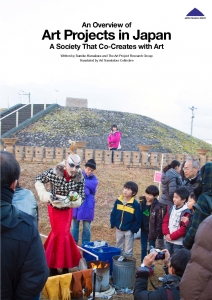

このプロジェクトは、アーツカウンシル東京が行っているTokyo Art Research Lab(TARL)主催の研究・開発事業「日本型アートプロジェクトの歴史と現在についての情報発信研究」の一貫として出版された『日本型アートプロジェクトの歴史と現在 1990年→2012年』(2013)の英語版を作成し、印刷物と電子版として発表したものです。
TARLで行われたアートプロジェクト研究に関する公開講座のコーディネートを担当した東京藝術大学 熊倉純子教授と長津結一郎氏の依頼を受け、必ずしも日本のアート事情に明るくない英語読者を対象とした英語版発行のための編集方針の提案・編集・翻訳・校正をすべて担当しました。
また、英語版用に熊倉氏が書き下ろした2編は、すでに発表されている『日本型アートプロジェクトの歴史と現在 1990年→2012年』(2013)の補遺として日本語でも再発表されました。
このプロジェクトでは、単なる言語の変換ではなく、言説の背景や読者の置かれる文脈を考慮した表現としての翻訳の提案を目指し、翻訳のあり方や編集方針について著者と対話を重ねながら制作を進めることができました。チームとして翻訳に携わることで、翻訳の作業に付随して発生するリサーチ・インタビュー・書き起こし・編集・校正なども包括的に行い、より総合的な視点から内容への様々な提案をすることが可能になったと考えています。
An Overview of Art Projects in Japan: A Society that Co-Creates with Art is an English edition of Nihongata āto purojekuto no rekishi to genzai 1990-2012 [Japan’s art projects: their history and present state, 1990-2012] (2013), published both digitally and in print. The two chapters in the report written for the English version was also published in Japanese as an addendum for Nihongata āto purojekuto no rekishi to genzai 1990-2012 [Japan’s art projects: their history and present state, 1990-2012] (2013).
This publication is an abridges version of a research project directed by Sumiko Kumakura, Professor at Tokyo University of the Arts, that was conducted over five years as a part of the Tokyo Art Research Lab. It summarizes the key points of the research for English-speaking readers who are familiar with recent trends in socially engaged art and social practice and want to know about the corresponding scene in Japan.
This publication was created through countless conversations regarding translation and how information on “art projects” in Japan should be framed for an English-speaking audience. As a collective, we were responsible not only for the translation but also editing, proofreading, conducting interviews, and managing the overall translation project. This comprehensive approach was an opportunity for us to reconsider the conventional role of the translator and think about how they could employ their knowledge of different languages and cultures to reframe and communicate information effectively.
 Email:
Email: 